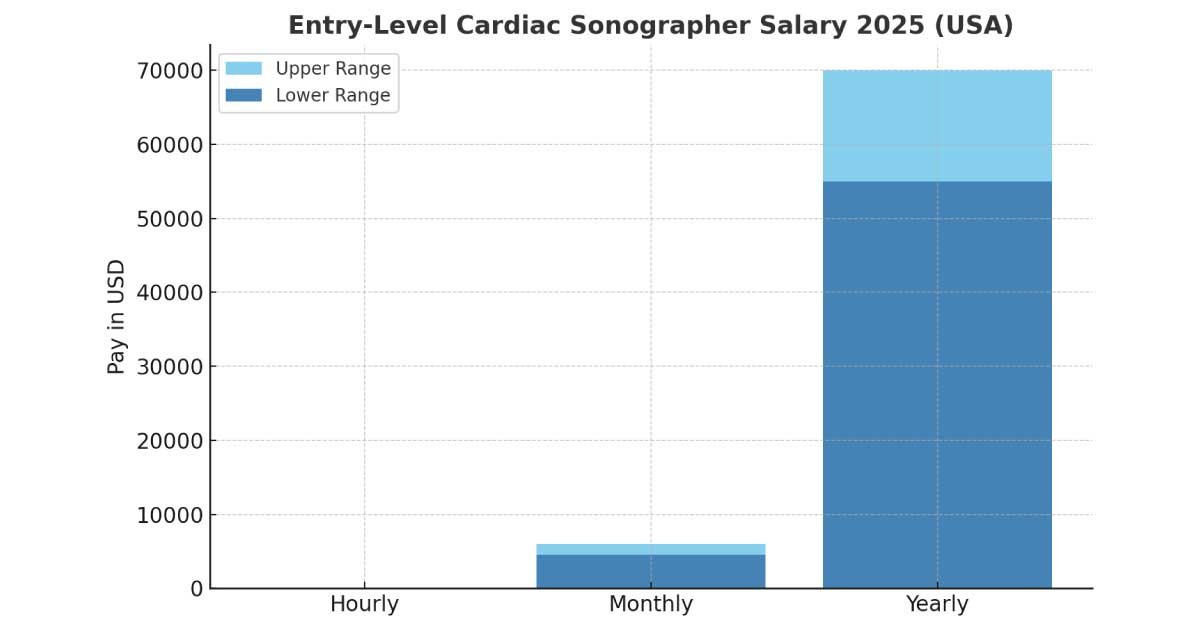Starting a career in healthcare can feel exciting and overwhelming at the same time. If you’re stepping into the role of a cardiac sonographer in 2025, one of the first questions you’ll naturally ask is: How much can I expect to earn?
The answer isn’t a simple one-size-fits-all figure. Entry-level salaries in this field depend on many factors, including location, credentials, workplace setting, and even the types of shifts you’re willing to take. The good news is that cardiac sonography is one of the more rewarding imaging careers both financially and professionally, offering a steady path of growth and security.
In this guide, we will break down what new cardiac sonographers are earning in 2025, explore the variables that affect pay, look at salary progression, and share strategies for maximizing your income right from the start.
What Does a Cardiac Sonographer Do?
Before diving into salaries, it’s important to understand the scope of this role. A cardiac sonographer, sometimes called an echocardiographer, specializes in imaging the heart using ultrasound technology. They conduct echocardiograms, Doppler studies, and advanced imaging that allows cardiologists to evaluate heart chambers, valves, and overall function.
At the entry level, your day might include:
-
Preparing patients and explaining procedures.
-
Operating ultrasound machines to capture clear, accurate images.
-
Assisting physicians with diagnosing heart disease or irregularities.
-
Documenting findings and maintaining patient records.
It’s a hands-on role that requires technical precision, compassion, and strong communication skills. Because of the specialized knowledge involved, employers value trained cardiac sonographers highly—even those just beginning their careers.
Entry-Level Salary in 2025: What You Can Expect
In 2025, the starting salary for a new cardiac sonographer remains competitive compared to other allied health careers. On average, most entry-level professionals earn between $55,000 and $70,000 annually in the United States. This usually translates to $27 to $35 per hour, depending on shift differentials and overtime opportunities.
At first glance, these figures may feel broad, but that’s because salary depends heavily on local demand and healthcare infrastructure. For example, a large metropolitan hospital will often pay more than a rural clinic. A freshly certified sonographer in New York may start closer to the higher end of the range, while someone in a smaller Midwestern town may see an offer on the lower side.
No matter where you begin, this field offers stability and growth. Even at the starting line, you’re already entering a profession that provides solid financial footing and clear upward mobility.
Entry-Level Cardiac Sonographer Salary 2025
| Pay Type | Lower Range (USD) | Upper Range (USD) |
|---|---|---|
| Hourly | $27 | $35 |
| Monthly | $4,500 | $6,000 |
| Yearly | $55,000 | $70,000 |
Factors That Influence Your Starting Pay
Why do two new cardiac sonographers with similar training sometimes earn different salaries? Here are the biggest influences:
1. Geographic Location
Healthcare salaries reflect the cost of living. Big cities like San Francisco, Los Angeles, and New York pay higher wages because housing and living expenses are steep. Meanwhile, rural hospitals often pay less but may balance it out with lower living costs or additional perks like housing assistance.
2. Education and Credentials
An associate’s degree in diagnostic medical sonography may be the minimum requirement, but employers often favor candidates who hold advanced certifications such as RDCS (Registered Diagnostic Cardiac Sonographer). Walking into your first job already certified can boost your starting offer by several thousand dollars annually.
3. Type of Facility
Hospitals typically offer higher pay due to higher patient volume and complexity of cases.
Outpatient clinics may pay slightly less but provide more predictable schedules.
Specialty heart centers often pay above average because of their focus on advanced cardiac imaging.
4. Shift Differentials and Overtime
Healthcare doesn’t run on a 9-to-5 schedule. Entry-level sonographers who are flexible with nights, weekends, or on-call rotations often see bigger paychecks thanks to shift differentials. Overtime also adds up quickly, sometimes making a noticeable difference in monthly income.
5. Demand and Shortages
Certain regions face shortages of trained sonographers. Employers in those areas may offer sign-on bonuses, relocation packages, or higher base pay to attract new graduates. This means job seekers who are open to relocating have more negotiating power.
Salary Growth Beyond the Entry Level
Starting pay is only the beginning of the story. Cardiac sonographers enjoy one of the clearest salary growth paths in allied healthcare. Here’s a rough timeline:
1–3 Years of Experience: Salaries often climb into the $70,000–$80,000 range as you gain confidence, speed, and independence.
5–7 Years of Experience: Specialization in pediatric, fetal, or advanced cardiac imaging can push salaries into the $85,000–$95,000 range.
10+ Years or Leadership Roles: Experienced sonographers who move into supervisory positions or advanced diagnostic specialties can exceed $100,000 annually in many regions.
This progression shows that your career is not limited to entry-level earnings. By continuously building skills, you can double your starting salary within a decade.
Real-Life Pay Examples
To make the numbers more relatable, here are two hypothetical scenarios:
Case 1: Urban Hospital Sonographer
-
-
Location: New York City
-
Starting Pay: $68,000/year
-
With shift differentials and occasional overtime: $74,000/year
-
Case 2: Rural Community Clinic Sonographer
-
-
Location: Small town in Texas
-
Starting Pay: $58,000/year
-
Lower cost of living makes take-home feel equivalent to $70,000 in a larger city.
-
Both examples show that salary is just one piece of the puzzle. Lifestyle, cost of living, and job perks must also be weighed.
Maximizing Your Income at the Start
If you’re about to accept your first role as a cardiac sonographer, here are steps you can take to make sure you’re earning the best possible pay:
Get Certified Early – Achieving professional certification right after graduation makes you more valuable to employers.
Be Flexible with Shifts – Agreeing to nights, weekends, or on-call status often comes with significant pay boosts.
Consider Relocation – Some regions pay much higher due to shortages. Moving can raise your starting salary by 10–15%.
Negotiate Benefits – Salary is important, but so are health benefits, tuition reimbursement, and retirement contributions. Don’t overlook the full compensation package.
Seek Mentorship – Partnering with experienced sonographers helps you learn faster and positions you for quicker promotions and raises.
The Bigger Picture: Job Security and Demand
While pay is a strong motivator, job stability is equally important. The demand for cardiac sonographers continues to grow in 2025 for several reasons:
-
Cardiovascular disease remains one of the leading health concerns worldwide.
-
Non-invasive imaging is preferred over riskier diagnostic methods.
-
An aging population requires more frequent heart evaluations.
-
Advances in ultrasound technology are creating new types of cardiac imaging.
This high demand means entry-level sonographers are stepping into a career that is not only financially rewarding but also secure against economic downturns.
Entry-Level Salary Compared to Other Imaging Fields
How does a new cardiac sonographer’s salary stack up against other entry-level imaging careers in 2025?
General Diagnostic Sonographers: $50,000–$65,000/year
X-Ray Technologists: $45,000–$60,000/year
MRI Technologists: $55,000–$68,000/year
Cardiac Sonographers: $55,000–$70,000/year
This comparison shows that cardiac sonographers consistently start at the higher end of the imaging spectrum, with faster growth potential in specialized roles.
Challenges to Consider
Of course, no career is without its challenges. New sonographers often face:
-
Long hours on their feet, especially in busy hospital settings.
-
Pressure to capture clear images in time-sensitive situations.
-
Emotional challenges when working with patients who have serious heart conditions.
-
The need for ongoing education to keep up with evolving technology.
While these factors can be demanding, most sonographers find the work deeply rewarding—both financially and personally.
Conclusion: Is Cardiac Sonography Worth It in 2025?
For those entering the healthcare field, cardiac sonography remains a smart choice in 2025. The entry-level salary of $55,000–$70,000 provides a strong foundation, and the growth potential over time is excellent. With high demand, good job security, and opportunities for specialization, this career path offers both financial and personal fulfillment.
If you are about to begin your journey as a cardiac sonographer, focus on building strong clinical skills, obtaining certifications early, and staying open to opportunities that push you slightly outside your comfort zone. The investment you make in the first few years will pay off, not just in your paycheck, but in the stability and pride you’ll gain from helping patients every day.
FAQs:
What is the average entry-level salary for cardiac sonographers?
Entry-level cardiac sonographers typically earn between $55,000 and $70,000 annually in the United States. This equals about $27 to $35 per hour. The exact figure depends on factors like location, type of healthcare facility, and whether you’re certified. Even at the start, this field offers competitive wages and reliable job stability.
Do cardiac sonographers make more in hospitals or clinics?
Generally, hospitals pay more than smaller clinics. Hospitals handle higher patient volumes and more complex cardiac cases, so they compensate sonographers accordingly. Clinics, while often offering steadier schedules, may pay slightly less. However, benefits, overtime, and shift differentials at hospitals can make a significant difference, even for those just starting their careers in 2025.
How do certifications affect starting salary for cardiac sonographers?
Certifications like RDCS (Registered Diagnostic Cardiac Sonographer) play a major role in starting pay. Employers often prefer certified candidates, and holding one at entry-level can boost your salary by several thousand dollars per year. It also makes you more competitive for specialized roles and faster promotions, helping you grow your career quickly and securely.
Can location really change my starting salary as a cardiac sonographer?
Yes, location heavily impacts your entry-level salary. Large cities with higher living costs, such as New York or Los Angeles, offer salaries closer to the upper range. Rural areas often pay less, though the lower cost of living balances things out. Relocating to high-demand regions can raise your income significantly, especially for newly trained professionals in 2025.
What is the salary growth potential after starting as a cardiac sonographer?
Salary growth in cardiac sonography is strong. With just a few years of experience, pay can rise into the $75,000–$85,000 range. Specializing in pediatric or advanced echocardiography can push it even higher. Experienced professionals with 10+ years or leadership roles often earn over $100,000. Entry-level pay sets a solid foundation for impressive career growth.
Are entry-level cardiac sonographers offered bonuses or extra pay?
Yes, many entry-level sonographers receive extra pay opportunities. Shift differentials for nights, weekends, or on-call duty add to income. Some hospitals also offer sign-on bonuses, relocation assistance, or tuition reimbursement. Overtime is another common boost, often making a noticeable difference in take-home pay. Altogether, these incentives can increase your annual earnings beyond the base salary.

